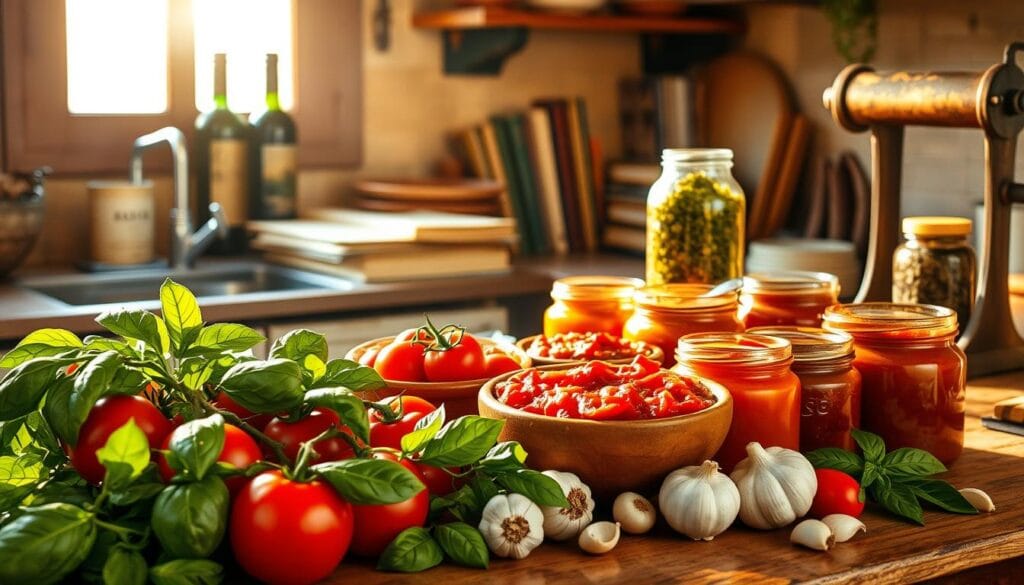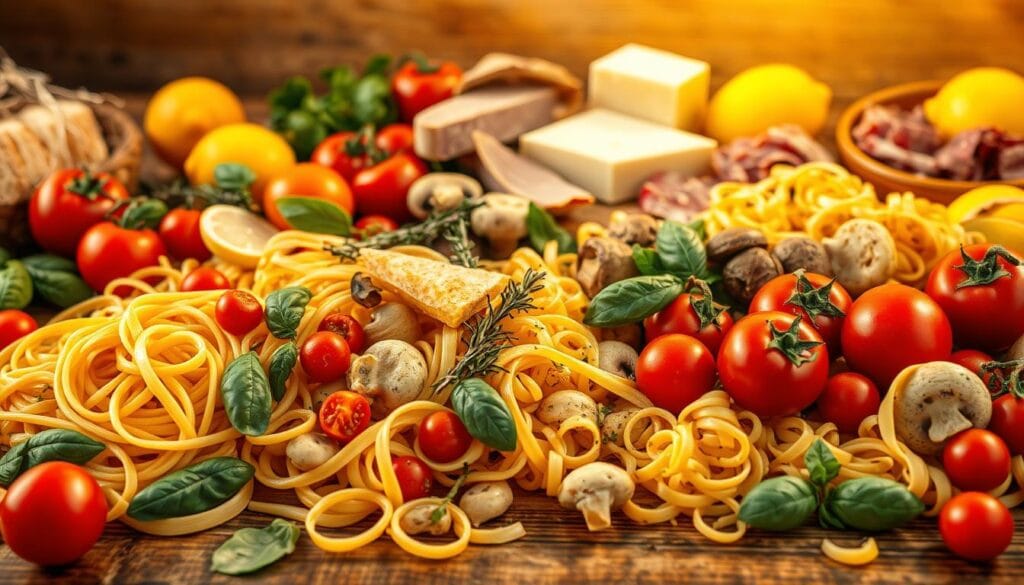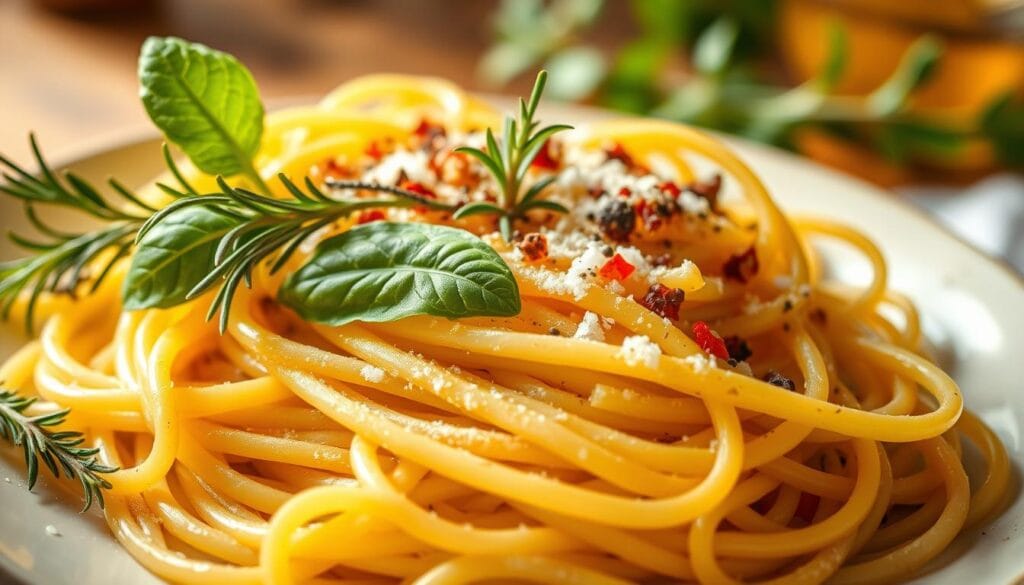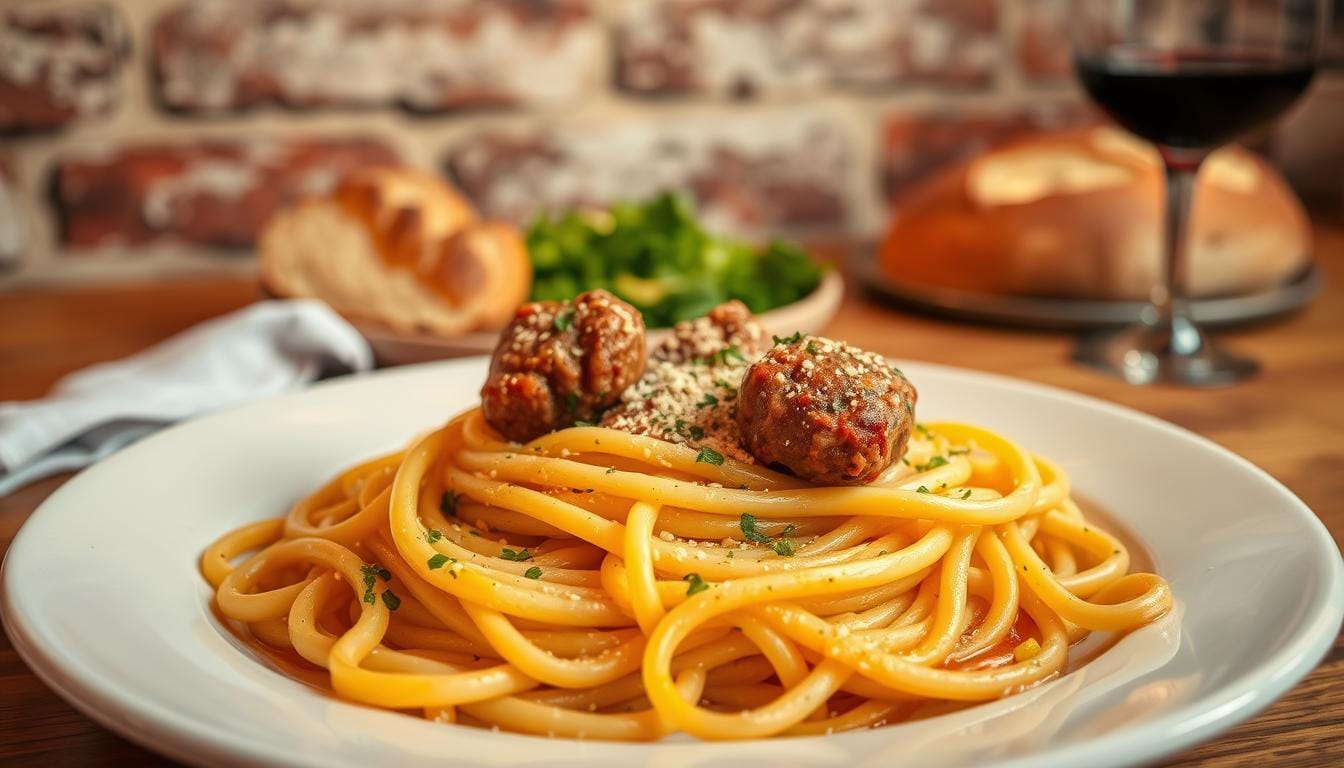What’s the first thing that comes to mind when you think of comfort food? For many, it’s a warm bowl of Italian pasta. Each bite connects you to family traditions and culinary art. In Italy, pasta is more than just food; it’s a language of love and a symbol of togetherness.
Whether you’re twirling spaghetti or layering lasagna, every dish is a chance to explore Italy’s heart and soul.
In this article, you’ll discover traditional pasta recipes that showcase Italian cooking’s beauty. You’ll learn techniques that turn a simple dish into something special. Making pasta at home is a joyful experience filled with creativity.
Let’s explore the authentic Italian pasta dishes that will change your cooking journey.
Key Takeaways
- Italian pasta is a cornerstone of authentic Italian cuisine.
- Pasta embodies a rich history infused with cultural traditions.
- Understanding pasta shapes enhances your cooking experience.
- Making pasta at home can be a joyful and rewarding activity.
- Pairing sauces with pasta shapes is essential for flavor balance.
- Seasonal ingredients can elevate your traditional pasta recipes.
Introduction to Authentic Italian Pasta
Authentic Italian pasta is more than just a meal; it’s a way of life and a rich tradition. Made from simple ingredients like flour and water, sometimes eggs, it has a unique charm. This charm attracts food lovers from all over the world.
The variety of Italian pasta makes it shine in many dishes. It goes beyond just food, becoming a key part of family meals. Sharing pasta dishes brings families together, creating moments of laughter and connection.
In Italy, families have their own cooking styles, showing how pasta fits into their culture and local ingredients. Whether it’s with tomato sauces or herbs, each dish is special. Exploring these traditions helps us appreciate the art and importance of pasta in our lives.
The Rich History of Italian Pasta
The history of Italian pasta is a captivating story that goes back thousands of years. Archaeologists found evidence of pasta in Italy over 2,000 years ago. It’s believed the Etruscans and Romans might have influenced its early forms.
As pasta became more popular, different areas started making their own special kinds. This led to the wide variety of pasta we see today.
Exploring traditional Italian recipes shows how important local ingredients were. For example, Emilia-Romagna is famous for its fresh egg pasta. This is because the region has lots of fertile land for growing crops.
In contrast, Southern Italy uses semolina pasta. This is because of the area’s wheat, giving pasta a unique taste and texture.
Pasta is deeply connected to Italian culture. It’s a symbol of family and food pride. Italian families love to come together for meals, often with homemade pasta at the center.
A brief look at key historical aspects reveals the following:
| Time Period | Key Developments |
|---|---|
| Ancient Rome | Introduction of early forms of pasta, such as lagane. |
| Middle Ages | Widespread recognition of pasta; early recipes emerging. |
| Renaissance | Refinement of pasta shapes; establishment of regional variations. |
| 19th Century | Industrialization leads to mass production of pasta. |
Types of Italian Pasta to Explore
Exploring Italian pasta is an exciting journey. You’ll find many shapes, each with its own charm. Knowing these differences makes your meals more enjoyable and helps you pick the right pasta for your sauce.
Common Pasta Shapes
Some popular pasta shapes include:
- Spaghetti: Long, thin strands perfect for lighter sauces.
- Penne: Short tubes ideal for hearty, chunky sauces.
- Fusilli: Spiral shapes that hold onto sauces beautifully.
These shapes play a key role in bringing out the flavors of your favorite dishes.
Unique Regional Varieties
Italian pasta also has unique regional varieties. Some examples are:
- Orecchiette: Ear-shaped pasta from Puglia, often paired with broccoli rabe.
- Strozzapreti: Twisted pasta that originated in Emilia-Romagna, often used in rich meat sauces.
- Bigoli: Thick, spaghetti-like pasta from Veneto, great for substantial sauces.
These varieties show the local traditions and ingredients, making each dish unique.
Exploring Italian pasta, from common shapes to unique regional varieties, is a culinary adventure. It’s sure to delight any pasta lover. With so many options, you’ll find the perfect pasta for every sauce and recipe.
Popular Italian Pasta Dishes to Make at Home
Exploring the best pasta dishes in Italy lets you bring delightful flavors home. Lasagna and spaghetti carbonara are two iconic dishes loved worldwide. They offer unique tastes and promote the joy of cooking homemade pasta.
Lasagna: A Classic Comfort Food
Lasagna is a layered dish with pasta, meat sauce, creamy béchamel, and cheese. It’s a favorite for family meals because of its comforting taste. Use fresh ingredients for a flavorful lasagna.
Traditional lasagna recipes include:
- Homemade pasta sheets
- Ground beef or sausage
- Fresh mozzarella
- Parmesan cheese
- Herbs like basil and oregano
Spaghetti Carbonara: A Roman Delight
Spaghetti carbonara is a simple yet rich dish from Rome. It’s made with spaghetti, eggs, cheese, cured pork, and black pepper. The dish highlights quality over quantity, making each ingredient stand out.
Here are the key ingredients for this classic:
- Quality spaghetti
- Pancetta or guanciale
- Fresh eggs
- Pecorino Romano cheese
- Freshly cracked black pepper
Both lasagna and spaghetti carbonara are beloved homemade pasta dishes. They invite everyone to try these classic recipes. Each dish not only satisfies but also honors Italian culinary traditions.
Homemade Pasta Dishes Worth Trying
Making homemade pasta is a rewarding experience. It brings a taste of authenticity to your kitchen. The process of making fresh pasta from scratch boosts your cooking skills and gives you a sense of accomplishment.
You can start by mastering the dough preparation method. This method is the foundation for all pasta types.
Creating Fresh Pasta from Scratch
To make homemade pasta, you need simple ingredients: flour, eggs, and a pinch of salt. You can use all-purpose flour or semolina flour for a better texture. Make a well in the flour, crack the eggs into it, and mix until a dough forms.
Let the dough rest for about 30 minutes. Then, roll it out and shape it as you like, from fettuccine to lasagna sheets. Next, cut and dry the pasta to let the flavors develop.
Filling Options for Ravioli and Tortellini
Homemade pasta dishes let you try different fillings for ravioli and tortellini. Classic fillings include ricotta with spinach. Meat lovers might prefer a beef and herb mix.
You can also mix roasted vegetables with cheese for a vegetarian option. Each filling adds a unique flavor, so you can customize your pasta to your liking.
Authentic Italian Pasta Sauces
Italian cuisine’s heart is in its pasta sauces. These sauces can make your meal special and show the beauty of Italian flavors. Each sauce has its own ingredients and ways of making it. Knowing about these sauces helps you make dishes that everyone will love.
Key Ingredients for Traditional Sauces
Making classic Italian pasta sauces needs just a few good ingredients. You’ll often find:
- Tomatoes – Fresh, canned, or puréed tomatoes are the base for many sauces like marinara.
- Herbs – Fresh basil and oregano add a lot to the flavor.
- Garlic – This aromatic ingredient adds depth to sauces.
- Olive oil – High-quality extra virgin olive oil is key for the authentic taste.
- Cheese – Parmesan or Pecorino Romano add creaminess and richness.
Pairing Sauces with Pasta Shapes
The joy of Italian dining is in the perfect sauce and pasta shape pairing. Some shapes hold sauces better, making the experience even better.
| Pasta Shape | Recommended Sauce | Flavor Profile |
|---|---|---|
| Spaghetti | Marinara | Bright, tangy, and refreshing |
| Fettuccine | Alfredo | Rich and creamy |
| Penne | Arrabbiata | Spicy and robust |
| Orecchiette | Broccoli Rabe and Sausage | Savory with a hint of bitterness |

Exploring Italian pasta sauces deepens your understanding of traditional cooking. Trying different pairings opens up endless possibilities. This makes every meal a delicious journey.
Culinary Techniques for Perfect Pasta Cooking
Learning how to cook pasta can boost your cooking skills. It lets you make real Italian dishes with ease. The key is to cook pasta al dente, which means it’s slightly firm. Also, knowing how to mix pasta with sauce is important for a great meal.
Cooking Al Dente: The Perfect Texture
To get the al dente texture, you need to pay attention to a few things:
- Start with a big pot of boiling water. Use lots of water so the pasta can move easily.
- Add a lot of salt. It makes the pasta taste better while it cooks.
- Follow the package’s cooking time, but taste it a minute or two early.
- Drain the pasta quickly when it’s just right.
By following these steps, your pasta will have a great texture. This will make your dish even better.
Tips for Tossing Pasta with Sauce
After cooking your pasta, mixing it with sauce is key. Here’s how to do it right:
- Save a little pasta water before draining. This water helps mix the sauce better.
- Put the sauce in the pan and add the pasta. Let the flavors blend.
- Use tongs or a big fork to mix gently until it’s all coated.
- Finish with a drizzle of good olive oil for extra flavor.
With these pasta cooking tips, you can make dishes that will wow your guests and satisfy your taste buds.
Italian Pasta and Seasonal Ingredients
Using seasonal ingredients can make your pasta dishes better. It matches flavors with the time of year. Fresh produce not only tastes great but also helps the planet.
Summer pasta dishes are all about juicy tomatoes and colorful veggies. They make for light, refreshing meals. On the other hand, winter pasta recipes use heartier ingredients. These offer warmth and comfort when it’s cold outside.
Best Fresh Ingredients for Summer Dishes
- Cherry tomatoes: Sweet and bursting with flavor, perfect for light sauces.
- Zucchini: Grated or sliced thinly, it adds texture and nutrition.
- Fresh basil: A fragrant herb that brightens any pasta dish.
- Peas: Sweet and tender, they complement summer ingredients well.
Hearty Ingredients for Winter Pasta Recipes
- Root vegetables: Carrots and parsnips can add depth to rich sauces.
- Pork or beef: These meats help create satisfying sauces perfect for cold nights.
- Mushrooms: Earthy notes that provide umami and hearty texture.
- Dark greens: Kale or Swiss chard can be incorporated for added nutrition.

The Role of Italian Pasta in Family Gatherings
Pasta is key in Italian family life, making meals special. It turns gatherings into cherished moments, creating memories and bonds. Sharing pasta meals brings warmth and strengthens family ties.
Traditional Sunday Pasta Dinners
Sunday pasta dinners are all about family in Italy. They feature dishes like lasagna and spaghetti, bringing everyone together. Families prepare together, filling the home with anticipation.
This meal is more than food; it’s a celebration of family and cooking love.
Pasta as a Guest-Favorite at Celebrations
Pasta is a hit at celebrations, loved by all ages. Penne arrabbiata and gnocchi are favorites at holidays and birthdays. Guests look forward to these dishes, made with love.
Its flexibility makes pasta perfect for any event, keeping it a family favorite.
| Type of Gathering | Typical Pasta Dishes | Cultural Significance |
|---|---|---|
| Sunday Family Dinner | Lasagna, Spaghetti Bolognese | Bonding over home-cooked meals |
| Holiday Celebrations | Fettuccine Alfredo, Gnocchi | Traditions passed down through generations |
| Birthday Parties | Pasta Salads, Mac and Cheese | Creating joy and celebration among friends |
Tips for Elevating Your Pasta Dishes
Improving pasta dishes starts with the right mix of ingredients. Adding fresh herbs and spices can boost flavors. Using quality olive oil and cheese turns simple dishes into masterpieces.
Adding Herbs and Spices for Flavor
Fresh herbs like basil, parsley, or thyme add vibrant flavors. Spices like red pepper flakes or black pepper add a nice kick. Try different combinations to find your favorite flavors.
Using Quality Olive Oil and Cheese
Quality olive oil and cheese make pasta dishes richer. A drizzle of good olive oil enhances the sauce. Pair it with Parmigiano-Reggiano or burrata for a gourmet touch.

Exploring Italian Pasta Beyond the Basics
Italian cuisine is a treasure trove of unique pasta dishes. These recipes often feature lesser-known pasta shapes that are key to regional flavors. Exploring Italian pasta reveals a world of flavors and textures. Each region has its own specialties, making every dish a new adventure for your taste buds.
Dishes Featuring Unique Pasta Shapes
Exploring Italian pasta introduces you to fascinating shapes that elevate your dishes. Here are some unique pasta options and their perfect pairings:
| Pasta Shape | Description | Best Pairing |
|---|---|---|
| Orecchiette | Small, ear-shaped pasta that holds sauces well. | Typically paired with broccoli rabe and sausage. |
| Fusilli | Screwy pasta that captures sauces perfectly. | Great with pesto or thick meat sauces. |
| Strascinati | Hand-rolled pasta resembling gnocchi. | Best served with a tomato-based sauce. |
| Campanelle | Bell-shaped pasta that resembles flowers. | Delicious in creamy sauces or with seasonal vegetables. |
Exploring Lesser-Known Italian Recipes
Try these lesser-known pasta recipes to deepen your culinary journey. They highlight unique ingredients and traditional cooking methods:
- Troccoli con Sugo di Polpo: A Puglian specialty made with thick spaghetti-like pasta and octopus sauce.
- Pasta alla Norma: A Sicilian dish featuring short pasta, eggplant, and tomato sauce.
- Bigoli in Salsa: A Venetian pasta made from whole wheat flour, served with anchovy sauce.
- Pici Cacio e Pepe: A Tuscan simple dish with hand-rolled pasta, cheese, and black pepper.
These unique pasta dishes and recipes invite you to broaden your culinary horizons. By exploring these diverse options, you can truly appreciate the artistry and flavors of Italian cooking.
Conclusion
In every Italian kitchen, there’s a special art of making authentic Italian pasta. This shows how much the nation loves pasta. From simple spaghetti aglio e olio to rich lasagna, each dish has its own story.
This tradition is not just about food. It connects families and communities deeply. It shows the value of using fresh ingredients.
Making pasta at home is a journey into Italian cuisine. You’ll learn new techniques and recipes. It’s more than just taste; it’s about culture, family, and love.
Every time you make a meal, you add to this rich tradition. So, get ready to try authentic Italian pasta recipes. Enjoy the process and the flavors as you connect with this beloved culinary art.


1 thought on “Authentic Italian Pasta Dishes to Try”
Comments are closed.